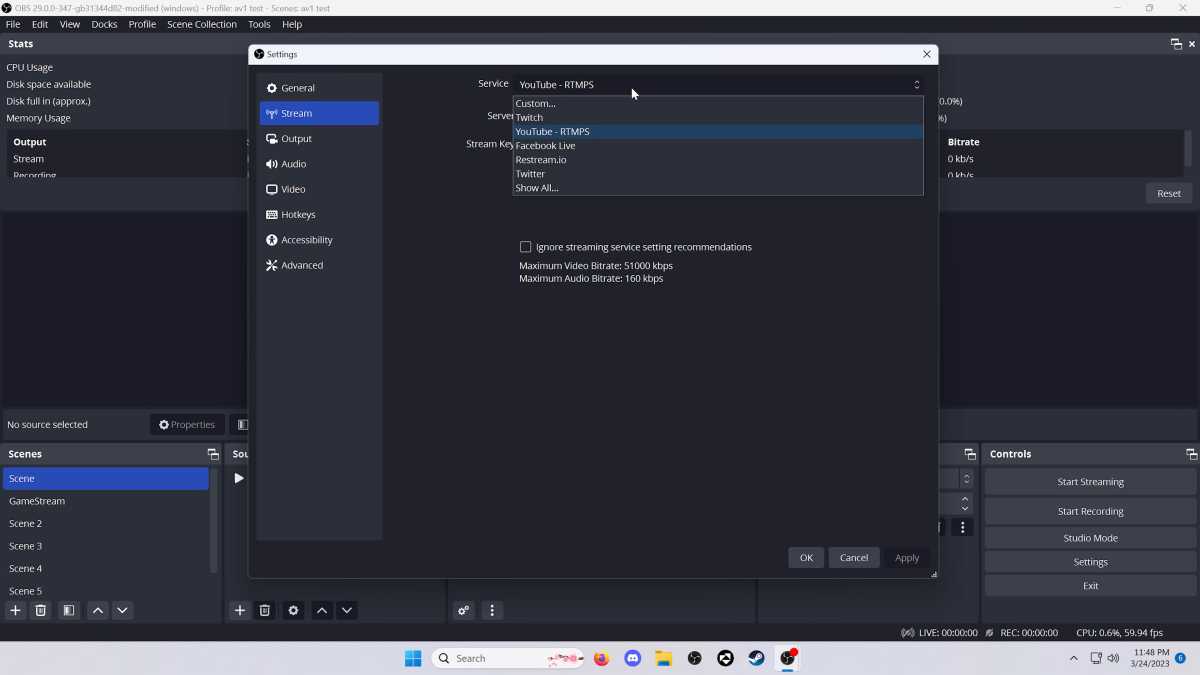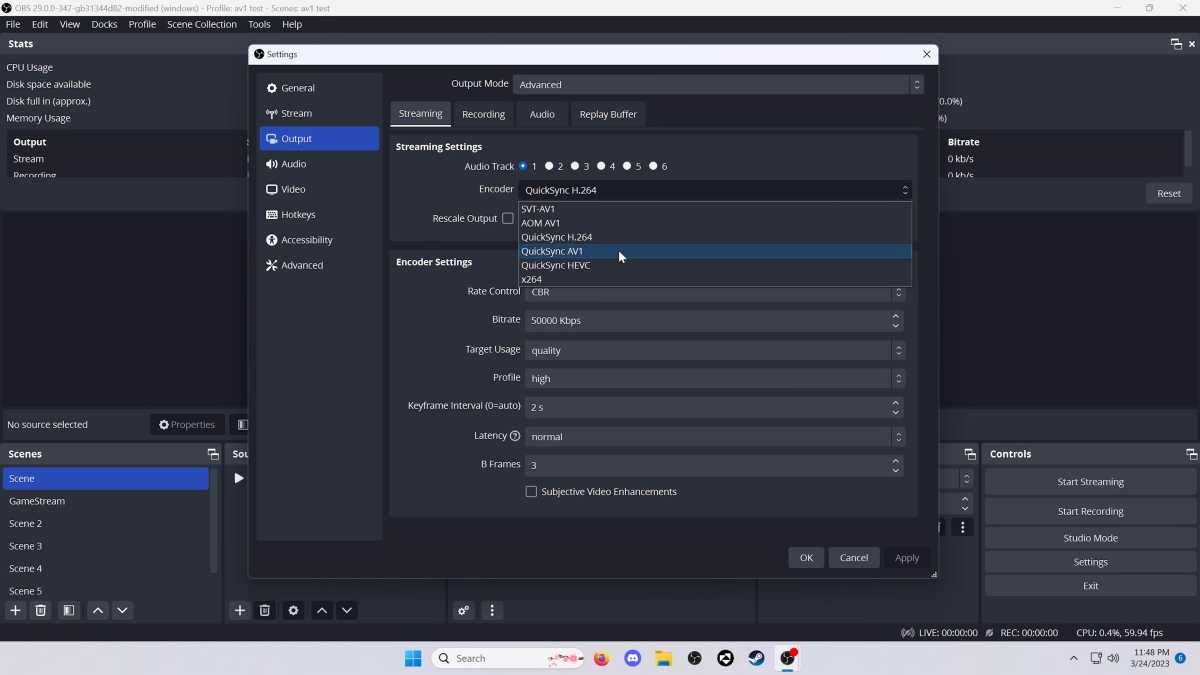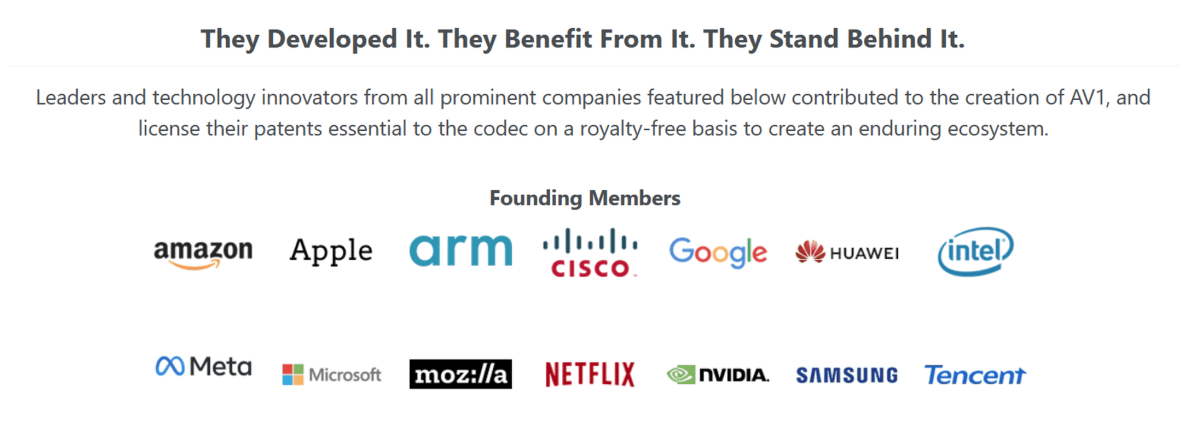The future of streaming is here: YouTube gets AV1 broadcasts
Live streams will start looking a whole lot nicer soon. YouTube has begun rolling out support for an updated streaming protocol, which when paired with the upcoming OBS Studio 29.1 update, will allow users to broadcast AV1 video, a.k.a. the future of GPU streaming.
The improvement is so substantial that users can stream great-looking 4K 60FPS video at just 6 megabits per second – a bitrate that historically been deemed “not enough” to produce high-quality 1080p streams in H.264 over on Twitch.
What is AV1?

At just 10mbps, an AV1 YouTube stream at 4K 60FPS looks far superior to most 1080p 60FPS Twitch streams at 6mbps.
Adam Taylor / IDG
AV1 is a new, open source video codec that aims to dethrone H.264 as the primary video standard after its nearly 20 year-long reign. AV1 is developed by the Alliance for Open Media – a consortium backed by lots of major tech corporations adjacent to streaming and video, including the likes of Google, Netflix, Arm, Apple, Amazon, Intel, Microsoft, and Nvidia.
The AV1 encoder has been very tough to run at high speeds when running in software on your CPU, but the past couple years have seen huge improvements to the efficiency of the available encoders. Over the past 9 months we’ve gotten graphics cards from AMD, Intel, and Nvidia that have hardware AV1 encoding built-in, allowing users to encode AV1 video in real-time with minimal performance penalty.
Enhanced RTMP
For the first time in 10 years, the RTMP streaming protocol spec has received an update, dubbed “Enhanced RTMP.” The highlight from this update is support for more video codecs: HEVC/H.265, VP9, and AV1. YouTube supports RTMP.
HEVC was already supported by YouTube using the HLS protocol – but that protocol didn’t always play nicely with some internet connections and typically brought higher latency to getting streams to viewers. Enhanced RTMP seems (in my testing) to carry the same latency that normal RTMP streaming had.
OBS 29.1

Adam Taylor/IDG
In the upcoming OBS Studio 29.1 update, users will be able to use these codecs by selecting “YouTube – RTMPS” in Stream settings. Then any available HEVC and AV1 encoders will be made available, including the SVT and AOM CPU-based AV1 encoders.

Adam Taylor/IDG
At the time of testing, only Nvidia and Intel hardware AV1 encoders are supported, but AMD support will be coming shortly.
Graphics cards that support AV1 encoding:
It’s also worth noting that Nvidia GeForce RTX 3000 and AMD Radeon RX 6000 graphics cards support AV1 decoding for playback, but do not support encoding on hardware.
Users of graphics cards going back to even Nvidia’s older GTX 10-series (GTX 1050 ti and higher) will be able to stream HEVC with this update, however, bringing higher quality streams to older GPUs too!
Lower bitrates
In my testing over the course of multiple multi-hour streams, you can achieve high quality, clear video with far lower bitrates than ever before.
Streaming 1440p 60FPS can look great with just 4-8mbps. 4K 60FPS can look great with just 10-20mbps. This is truly game-changing—both for people with limited upload bandwidth and those with not much hard drive space for recording capacities.
Currently, AV1 streams to YouTube are not delivered to viewers in AV1. As YouTube always transcodes the videos and streams it ingests (compared to Twitch, where the default is “Source Quality” untouched by compression), streams at higher than 1080p resolution (1440p and 4K) will be delivered to viewers in VP9, and 1080p and lower streams will be delivered in either AVC (H.264) or VP9, depending on viewership. This doesn’t significantly impact quality more than expected, and VP9 does a great job at preserving image integrity over blocking and artifacts.

This isn’t a great-looking stream, but it’s quite familiar to those who browse random Twitch streams. But this isn’t the typical 3.5-4mbps Twitch stream, this is 1440p60 at a mere 500kbps streamed to YouTube!
Adam Taylor/IDG
In my testing, I did notice that the various AV1 encoders did struggle to stick to their exact-specified CBR targets I entered in OBS – but it wasn’t a huge issue, and the overall gained headroom makes up for it.
I even tested as low as 500kbps for 1440p60 and while it was obviously a pixelated mess, my viewers determined it was still surprisingly watchable compared to a lot of current 1080p Twitch streams.
The Future of Streaming
This is a huge win for YouTube and immediately starts allowing creators to save on bandwidth and gain quality within their live streams. As hardware continues to improve AV1 performance, more and more streamers will start using this feature.
But some questions about the future of AV1 implementations still remain.

Alliance for Open Media
First I have to wonder, when will Apple start supporting AV1? Apple is an early AOM member, having joined in 2018, but they’ve never once listed AV1 decode support within their hardware specs—even when plenty of game consoles, smart TVs, and other Android devices have implemented multiple generations of support. Knowing Apple, I wouldn’t be surprised if they are waiting on the “right moment” to announce that the current generation (be it M2 or iPhone 14 or 15, whatever is the latest generation at the time) of hardware has had AV1 support this whole time and they’re just now turning it on—probably announced at WWDC or another similar event. But thus far, they’ve been silent on the topic.
Speaking of silence, there’s also the question of Twitch. The streaming giant has been pretty quiet about their original AV1 Roadmap since their Principle Video Engineer Yueshi Shen left for TikTok in 2021. I hope AV1 is still on track for Twitch, especially since an updated RTMP spec should be easier to implement than a whole new protocol. Unfortunately, we have no way of knowing at this time. Adding to the discomfort, Video Encoding and Playback Software Engineer “M3U8” suggests Twitch has a lot of work ahead of them to implement this update:
Should Twitch nail AV1 support sometime soon, they may have an advantage over YouTube for visual streaming quality for the first time. Since Twitch defaults to “Source” quality – a stream that isn’t compressed between streamer and viewer – the advantages of low-bitrate AV1 streaming will be much more apparent to the viewer than the same stream transcoded by YouTube’s VP9 encoders.
Only time will tell, but competition is ramping up. Enjoy those drool-worthy YouTube AV1 streams!
For all the latest Technology News Click Here
For the latest news and updates, follow us on Google News.
